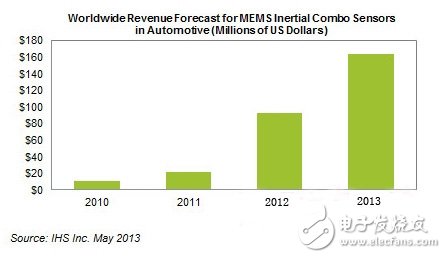Market research company IHS iSuppli pointed out that, thanks to the rapid popularization of automotive safety regulations and the application of automotive safety systems in recent years, the market for composite MEMS inertial sensors for automotive applications is expected to reach a scale of US $ 163 million in 2013, a substantial growth of 77% .
IHS said that as more and more cars are introduced into safety systems, the use of these types of sensors in cars is also increasing rapidly. Last year, this type of sensor market grew by about 338%, reaching a market size of 92 million US dollars, which is a significant increase from 2011's 10 million US dollars.
A compound inertial sensor refers to a multi-sensor element that integrates an accelerometer and a gyroscope in a single package to provide inertial input for an electronic stability control system (ESC) in a car to avoid or reduce slippage.
"In North America, Europe, and other places where regulations are mature, such as Australia, Japan, Canada, and South Korea, it is mandatory for cars to adopt the ESC system," noted Richard Dixon, principal analyst of MEMS and sensors at IHS. However, "in some undeveloped There are still huge business opportunities in the field. For example, China provides a larger market, which will obviously affect the penetration rate of ESC in the world. However, from another perspective, it will also be a composite sensor for the overall vehicle. Bringing huge growth drivers and kinetic energy. "

Global composite MEMS sensor market revenue forecast (unit: million US dollars)
IHS stated that the major suppliers of automotive inertial sensors include Bosch (Germany) and Murata (formerly VTI); there are also two potential manufacturers-Panasonic (Japan) and the US headquarters Massachusetts's Analog Devices (ADI), also need to develop similar solutions to successfully grasp this market opportunity.
The current ESC system for automobiles includes three architectures: the first is to be placed on the circuit board like an independent ESC engine control unit (ECU). The second architecture is connected to the brake modulator to save wiring. The third type of ESC system is configured together with the automotive airbag ECU.
In these three different configurations, the current trend is to adopt the method of placing the ESC system in the airbag ECU to achieve a smaller footprint and higher efficiency, especially in the car. The space of the ECU position is very limited Therefore, it is more advantageous to adopt a space-reducing architecture.
Compared with the stand-alone sensor configuration, the sensor (such as the product developed by ConTInentail) manufactured for the combined sensor ESC system architecture can reduce the space by up to five times, IHS emphasizes. Non-combined solutions also exist in the form of separate installation on the circuit board. IHS said that deploying sensors in a compound way can not only reduce the packaging cost, but also because the two sensors in the compound package can share the same ASIC, it can save the use of expensive semiconductor components as much as possible.
One of the most important issues in the ESC system is cost. IHS explained that this is because ESC was considered an optional equipment in the car; however, since the government forced the ESC system, it has now become a car like a seat belt The necessary accessories.
Therefore, in the entire supply chain and pricing structure, automotive composite sensors have undergone tremendous pressure from car manufacturers to the downstream. First-tier manufacturers pass this pressure on to their suppliers, demanding accelerated provision of high-efficiency compound sensor solutions for ESC system inertial sensors.
IHS emphasized that under this pressure, some first-line players believe that in the future, only the traditional business will adopt the traditional configuration scheme of PCB with independent sensors. Therefore, all new cars in the future will use a compound sensor solution.
Tower Air Fryer,Air Fryer 3.5L,Digital Air Fryers,Industrial Air Fryer
Ningbo Anbo United Electric Appliance Co.,ltd , https://www.airfryerfactory.com